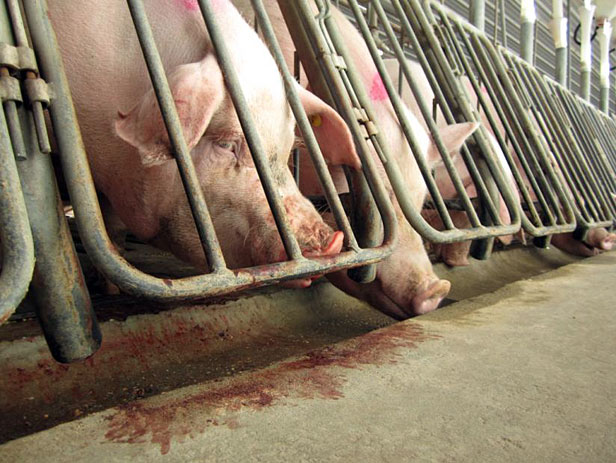 Sow crates are spattered with blood from chewing and other atypical behaviors.Photo: Humane Society
Sow crates are spattered with blood from chewing and other atypical behaviors.Photo: Humane Society
The year is not ending well for the meat industry. Last week, after years of dodging the question, the FDA revealed the amount of antibiotics the industry pumps into the unfortunate animals it holds in confinement. Turns out that Big Meat has been drastically underestimating its routine drug use — while blithely helping nourish antibiotic-resistant “superbugs” in the process. Thanks, guys.
And this week, the ever-heroic Humane Society of the United States released a stark report, including video, from inside a factory “farm” run by Smithfield, the globe’s largest pork producer. Once again, an HSUS inspector has snuck into an animal factory posing as a worker, documenting the horrors therein. Given the near absence of proper oversight of animal factories by the USDA (which oversees meat) and the FDA (eggs and dairy), HSUS has become our shadow regulator, the eyes through which the public can see what the industry gets up to behind its well-guarded gates. (It has also done vital recent work on the industrial-egg industry.)
It ain’t pretty. I sure hope those investigators get PTSD counseling.
Here’s the short video. There’s a longer one, for the steely-hearted, and a slideshow for the less so.
The focus here is gestation crates — a housing method used by the industry to “efficiently” tend pregnant sows. The HSUS report says:
Female breeding pigs were crammed inside “gestation crates” so small the animals could barely move for virtually their entire lives. The animals engaged in stereotypic behaviors such as biting the bars of crates, indicating poor well-being in the extreme confinement conditions. Some had bitten their bars so incessantly that blood from their mouths coated the fronts of their crates. The breeding pigs also suffered injuries from sharp crate protrusions and open pressure sores that developed from their unyielding confinement.
Despite the suffering and potential for infection from wounds, medical attention is virtually absent from the scene — and when care is administered, it’s outright malicious. Reports HSUS:
The investigator never saw a veterinarian at the operation. A barn manager told the investigator to ignore a pig with a basketball-sized abscess on her neck, and then cut the abscess open with an unsterilized razor.
How does the company even manage to keep these tortured animals alive until they give birth? I guess those daily lashings of antibiotics do the trick.
For its part, Smithfield has whipped itself into PR overdrive, issuing a press release announcing it had hired the renowned animal-welfare expert Temple Grandin to help with an “ongoing investigation” of the incidents captured on film. Perhaps the incident will compel the company to keep its 2007 promise to phase out gestation crates by 2017 — a slothful pace the company had already signaled it simply can’t stick to, reports HSUS.
Note that government regulators have nothing to do with this process. Glacial as its pace is, reform in the meat industry is being driven by consumer outrage generated by NGOs like HSUS. Why might that be? Well, a recent Union of Concerned Scientist survey of rank-and-file FDA and USDA employees portrays agencies essentially under heel of the industries they’re meant to regulate.
And the campaign-finance/lobbying tracker Open Secrets suggests an answer as to why. Reports Open Secrets:
Individuals and political action committees associated with the meat industry contributed $1.6 million to the candidates at the federal level during the 2008 campaign cycle, with nearly 70 percent going to Republicans. The industry is a strong supporter of the GOP, and has given the party more than three-quarters of the $10 million of its contributions made since the 1990 election cycle. The industry’s contributions have remained fairly steady — in the range of $1.1 to $1.7 million — since the 2000 campaign cycle.
The industry also floods the Hill and regulatory agencies with lobbyists:
On the federal lobbying front, the industry has markedly increased its expenditures throughout the last decade, from less than half a million dollars to high of $6.2 million in 2008. In 2009, the industry spent $5.6 million on lobbying, with top spender Tyson Foods accounting for nearly $2.5 million — more than double what the company spent just two years before in 2007. Smithfield Foods — maker of Butterball turkeys — spent $1.3 million.
With the Republicans resurgent in Congress and Obama in retreat from progressive ideals, it’s hard to imagine that our regulatory agencies will grow a backbone and begin to defend the public interest against industry’s cheap-food-at-any-cost demands.
Until they do, thank goodness we have the Humane Society acting as our eyes on the meat-factory floor.



